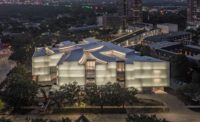Clad in hard hats and fluorescent vests, visitors to the John F. Kennedy Center for the Performing Arts got a sneak peek on Tuesday of the REACH, a cluster of new structures adjacent to the 47-year-old building, by Steven Holl Architects (SHA). Conceived as three interconnected pavilions, the Kennedy Center’s first-ever expansion will add 72,000 square feet of interior space and increase public areas by more than 20 percent.
The $175-million project includes flexible spaces for rehearsals and performances; areas dedicated to education, including a Learning Lab, classrooms, and lecture halls; a welcome pavilion and a café; and outdoor recreational facilities, including a green roof, a plaza and community lawn, a pedestrian bridge, and a reflecting pool.
At yesterday’s construction tour, visitors watched a performance inside the REACH’s dramatic Skylight Pavilion, a board-formed concrete structure with 36-foot ceilings and expansive views of the river. When asked about the material relationship between this project and the original Kennedy Center building, Holl said, “We wanted to make a relationship to the Edward Durrell Stone building without having to sheath the building in Carrera marble.” Instead, SHA opted for structural concrete, tinted titanium white to match with the marble of the 1971 original.
Inside the pavilion, a novel acoustical finish that Holl calls “crinkle concrete” covers the walls. Form liners created peaks and valleys in the concrete, giving the material a texture that Holl says “reacts with sound in a way that’s much better than acoustical tile.” He and SHA colleagues Garrick Ambrose and Chris McVoy pioneered the treatment, experimenting first in studio, then working with an acoustic engineer.
The REACH will open to the public on September 7, 2019, and will host a week-long celebration with free activities and performances.
Deane Madsen contributed reporting.
Video courtesy Work Zone Cam














